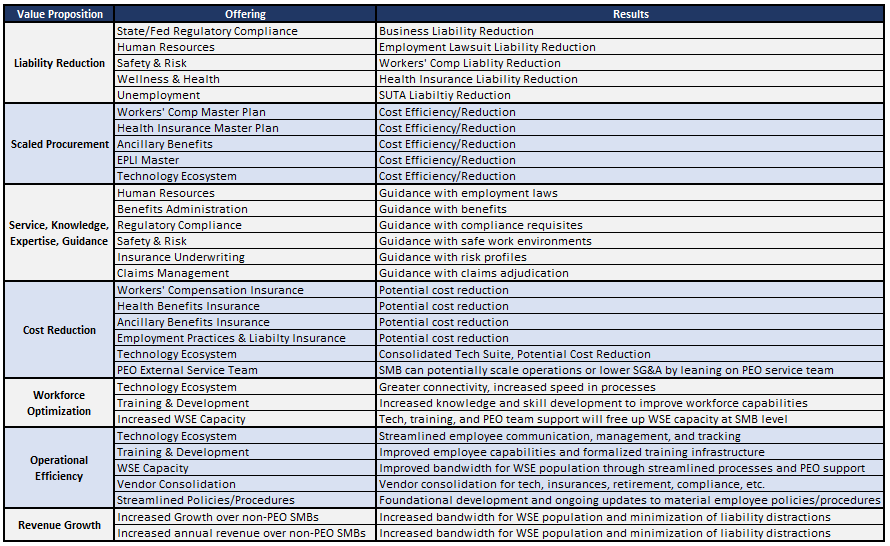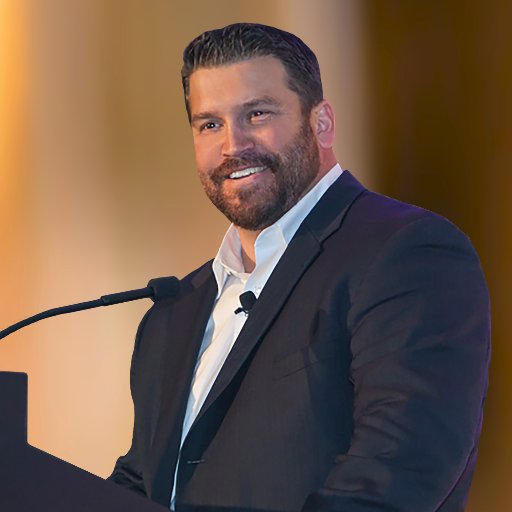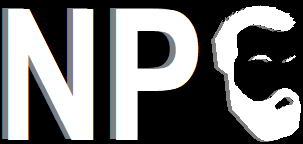The PEO Value Proposition
After reading this article, your view on what constitutes the PEO value proposition may shift. When I ask PEO professionals about their company’s value proposition, they typically provide a list of services that their PEO offers. A PEO’s value proposition is the impact it makes on its clientele, not solely its service offering. The service offering is the engine that drives the value proposition, but make no mistake, it is not the value prop by itself.
The PEO value proposition may not be what your sales team is conveying to potential buyers. If I were to ask 100 PEO sales professionals to explain to me their company’s value proposition, I would venture a guess that 98+ would give me a run down of their services. From my experience, we have conducted a number of sales training projects for PEO clientele, and thus far, 100% have given me this type of answer (service offering as the value prop). Or I will receive an answer that the PEO’s value prop is that it is an HR outsourcing company.
So, what is the PEO’s value proposition? As previously stated, it is the impact the PEO has on its clientele, i.e. SMBs and WSEs. Within the PEO model, there are a number of impact points driven by the PEO. In our sales trainings, we call these various impact points our “anchor themes.” Every part of the PEO offering, to one degree or another, can be tied back into these anchor themes. This is why we have labeled these impact points as anchor themes. Meaning, you can anchor your entire service offering back to these value proposition drivers.
Anchor Themes
An anchor them may take many forms, but in the PEO model it typically will look like the following:
- Liability Reduction
- Scaled Procurement
- Service, knowledge, guidance, expertise
- Cost Reduction
- Workforce Optimization
- Operational Efficiency
- Revenue Increase
It is the mastery of understanding these anchor themes, and the application in which the PEO model fits within these themes, that provides the context to discuss the PEO’s value proposition. These anchor themes driven by the service offering are the actual PEO value proposition. Meaning, these themes are the results that a good PEO will drive at an SMB and WSE level.
Illustrating the PEO’s True Value Proposition is Important
As a CEO of a business, when a salesperson contacts me, I can tell you without hesitation that I will only open up about the details of my business once I know that I want to do business. Therefore, I need to see the potential value and impact you will have on my business before I get too deep into the particulars about my business. CEOs are typically stretched for time. They understand what a good business relationship looks like, and they are painfully aware of the cost of a bad relationship. When a buyer sees the value your PEO may bring to the table, they are more open to listen to how this value may be achieved, i.e. the service offering.
In a meeting, if a PEO salesperson told me that their company could reduce my liability, offer scaled procurement on my insurance programs and technology suite, potentially reduce my expenses, help optimize my workforce, provide operational efficiency, offer a qualified team of experts to educate and guide my organization in employment related matters, and free my staff up to focus on revenue growth, I would be interested in hearing more.
Once I understood the execution model, i.e. service offering, I would view the relationship as a partnership, not as a vendor relationship. Why? Because I would believe that the PEO could impact my business in a material way.
Conversely, if I was pitched the services, without understanding the true value prop of the PEO, I would view the relationship as a vendor scenario. It may be a close vendor relationship, or a consolidated vendor relationship, but until I completely grasp the true value the PEO brings to my company, I would not consider it as a partnership.
Examples of Tying in the Service Offering to the Anchor Themes
There are way too many examples of tying the service offering into the anchor themes to cover in a short article. However, for example purposes, I will provide you with a few so that you understand the thought process behind this exercise.
It is recommended that you review your PEO’s entire service offering to determine how each segment would tie back into the anchor themes your organization will establish.
We will take each one of the example anchor themes from our previous list in this article, and provide an overview of how PEO service offering aligns with the PEO’s value proposition. (click on picture to enlarge if needed)

Concluding Remarks
There are many more examples we could provide with the PEO service offering and how it ties into the value prop anchor themes. However, it is important that the PEO’s internal team go through this exercise themselves in order to truly understand the applicability in their communication to prospective clientele.
When we conduct trainings, we do a deep exercise, specific to that PEO, to help them understand how to recognize, convey, and execute upon the value prop. However, for the sake of length with this article, we hit the themes high-level. Plus, I would never want to rob the PEO’s internal team from the light that “clicks on” when going through this exercise.
The key takeaway for this article is simple; do not misconstrue your PEO’s value proposition. Doing so will result in lower than optimal close ratios. It will also erode pricing elasticity due to a lack of perceived value at the SMB level, or at a minimum, it will make price more sensitive than it should be since the client hasn’t fully recognized the true value of the PEO.
Understanding and ultimately conveying the PEO’s value prop is a learning process. It is likely a shift from how most sales professionals approach the PEO model overview. However, when this method is mastered, it allows the PEO to truly covey the value prop to its perspective customers, resulting in better relationship expectations, appropriate price to value ratios, and distinction from competition.
Author

Rob Comeau is the CEO of Business Resource Center, Inc., a business consulting and M&A advisory firm with a niche focus on the PEO industry. To contact Rob, you may email him at rob.comeau@biz-rc.com. To learn more about BRC’s training programs and availability, please contact us at (949) 510-1126.
